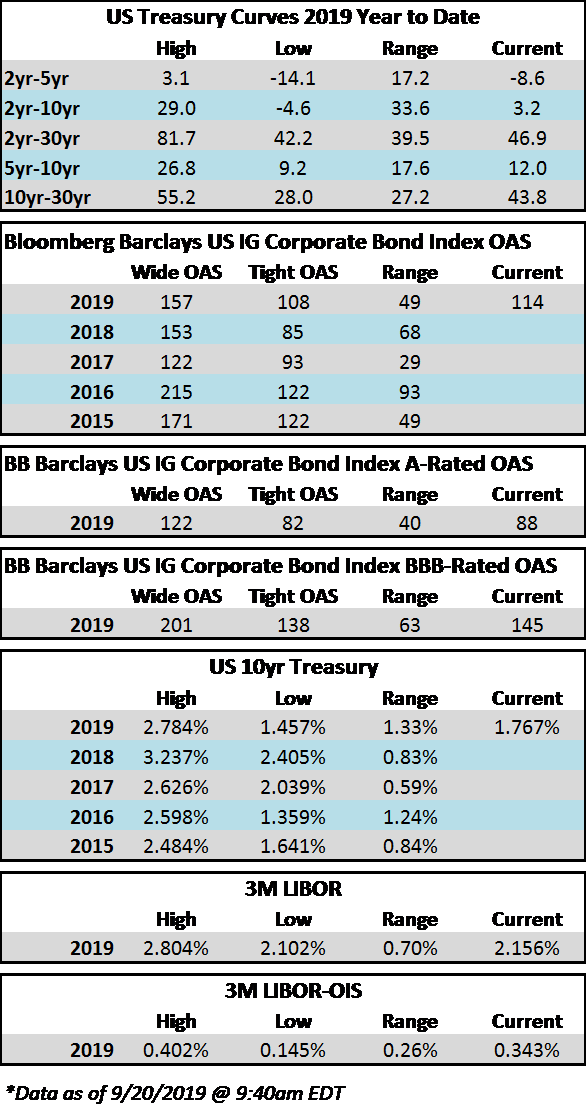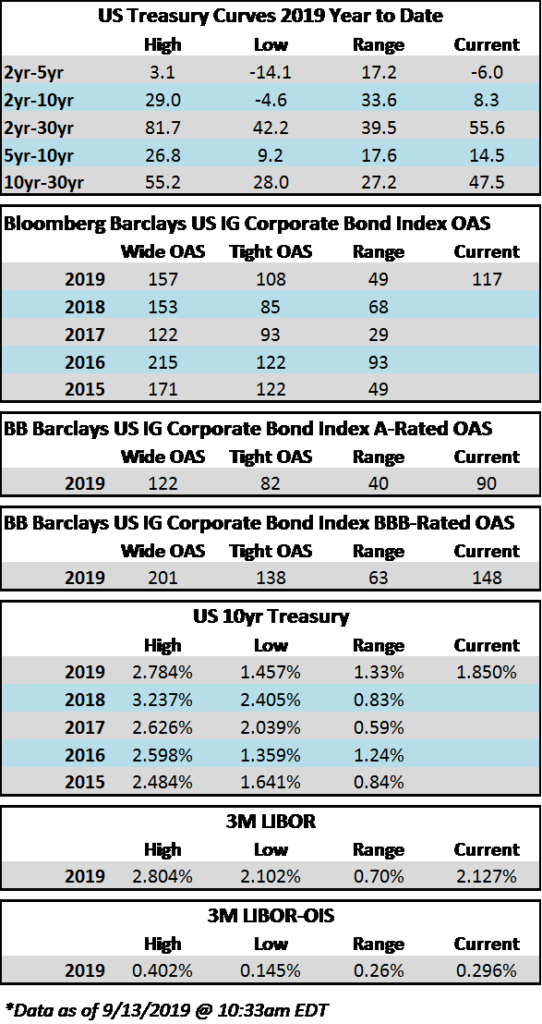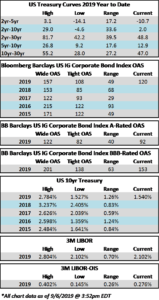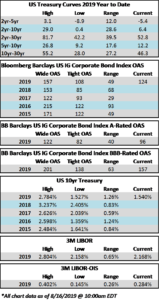Fund Flows & Issuance: According to a Wells Fargo report, flows week to date were -$0.1 billion and year to date flows stand at $18.0 billion. New issuance for the week was $5.9 billion and year to date HY is at $193.9 billion, which is +33% over the same period last year.
(Bloomberg) High Yield Market Highlights
- S. junk bonds are headed for their first weekly loss since mid-August after posting negative returns for three straight sessions and seeing fund outflows in the week.
- The 0.06% decline Thursday was led by the energy sector and extended a weekly loss to 0.21% and pushing yields to 5.67%, Bloomberg Barclays index data show
- Triple-Cs led the slump with a 0.12% drop, their eighth straight decline; yields on the debt climbed 6bps to 10.64%
- Single-B yields dropped 1bp to 5.68%
- BB yields rose 1bp to 4.10%
- Energy index has recorded losses for four consecutive sessions and seven of the last 10
- Investor caution spurred demand for higher- quality issuers as was evident in the pricing of AMN Healthcare on Thursday, which priced $300m at a yield of 4.625%, less than the initial talk of a 4.75% area
- Earlier in the week, Qorvo and Beacon Roofing, both BB credits, priced at the lower end of talk after drawing orders more than 3x the deal size
- On the other end of the spectrum, B1/B rated Shutterfly bonds are now pricing at a discount of 95 with an 8.5% coupon to fund its buyout by Apollo. The acquisition closed Sept. 25
(Bloomberg) New Twist in Red-Hot Junk Debt Market: Some Deals Are Flopping
- At a quick glance, everything seems wonderful in the world of risky credit. In September alone, companies have raked in more than $52 billion by tapping the U.S. leveraged-loan and high-yield bond markets.
- In recent weeks, a slew of companies — typically those considered the riskiest of the risky — have been forced to either ratchet up interest rates or dangle sweeteners to drum up investor demand and complete deals. A few more — including at least four this month — have been yanked from the market entirely.
- One common refrain coming from investors is that they don’t want to touch companies with excessive debt, especially those from struggling sectors or with businesses that could suffer more in a downturn. Particularly problematic: companies rated B3 by Moody’s Investors Service, one step away from the junk market’s riskiest tier.
- “If you’re looking to finance an LBO in the wrong sector or a business vulnerable to a slowdown, that’s tougher,” said John Cokinos, co-head of leveraged finance at RBC Capital Markets. “The loan market has limited appetite for new B3 rated deals, and the high-yield market is pushing back on highly levered deals.”
- September was the busiest month of the year for leveraged-loan launches as well as for speculative-grade bond pricings. And yields on junk bonds reached the lowest in almost two years. That points to a risk-on market for investors looking for greater returns in a world with $15 trillion of negative-yielding debt.
- But those days may be numbered with a slowdown weighing on investors’ minds.
- The pushback on recent LBOs is a sharp contrast to a year ago, when multibillion-dollar buyout financings — including those for Refinitiv and Envision Healthcare — were flying off the shelf despite some of the worst investor protections ever seen. Since then, though, there’s been a clear shift toward quality.
- To be sure, debt perceived as more resilient in a weaker economy has flown off the shelf, reinforcing the flight-to-quality that has dominated the market for the last few weeks. There was a frenzy, for example, for junk bonds issued by chicken chain Popeyes. They sold earlier this month at one of the lowest-ever yields for eight-year securities at just 3.875%.
- “For repeat and seasoned high-quality issuers in both high yield and leveraged loans, there’s a strong investor bid,” Cokinos said.
(Bloomberg) The Unusual Debt Maneuver That Inched Peabody Closer to Coal JV
- Peabody Energy Corp.’s plan to merge some of its operations with those of Arch Coal Inc. needed help from investors. They’d either have to agree to refinance its debt or amend its credit agreement to allow the deal.
- It struck out on the first option, scrapping proposed loan and bond refinancings after investors pushed back. In the end, it figured out a way to bypass the syndicated loan market altogether — with an unusual move that’s now angering some of the company’s lenders.
- The biggest U.S. coal producer increased the size of a revolving credit facility to $565 million, making it the largest slice of the company’s existing loan package and giving those lenders enough clout to approve the loan agreement amendment Peabody needed, according to people with knowledge of the matter. The amendment helps pave the way for Peabody’s planned joint venture with Arch Coal, which it is seeking to help it produce the commodity more competitively amid waning demand from the electricity industry.
- Investors in its existing term loan were not impressed by the move, which prevented them from potentially being able to extract a higher interest rate or earning a fee for agreeing to the amendment. The loan’s price dropped to around 95 cents after Peabody announced the completed amendment on Sept. 17, the steepest decline since it obtained the $400 million debt in 2018. In an unusual step, Peabody also announced in a separate filing on that day that it had switched the administrative agent on the loan agreement to JPMorgan from Goldman Sachs Group Inc. The administrative agent typically shepherds through any amendments to borrowing accords.
- Peabody’s credit agreements covering its loans had given it leeway to upsize the company’s $350 million revolving facility due in 2020 by $215 million. Peabody said Sept. 17 it had successfully upsized that borrowing and obtained the loan agreement amendment. By upsizing the revolver, the lenders of that facility held the majority of voting power, which allowed the loan amendment to pass without needing consent from existing term-loan investors, said the people familiar with the matter, who asked not to be identified because the matter is private.
 (Bloomberg) The Repo Market’s a Mess. (What’s the Repo Market?): QuickTake
(Bloomberg) The Repo Market’s a Mess. (What’s the Repo Market?): QuickTake

